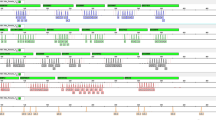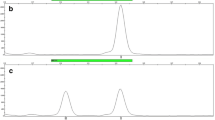Abstract
DNA profiling of short tandem repeats (STRs) is the primary method for genotyping forensic samples. However, degraded DNA and trace samples are still major problems for commercial 5- or 6-dye STR kits. In order to improve the performance of this method, we developed a novel 8-dye STR multiplex system containing 18 autosomal loci (D3S1358, D1S1656, TPOX, D16S539, vWA, D6S1043, D2S1338, CSF1PO, D19S433, D7S820, FGA, D8S1179, D5S818, D13S317, TH01, D21S11, D12S391, and PentaD) and the sex-determining locus Amelogenin, with all fragments smaller than 330 bases. Validation was carried out as recommended by the Scientific Working Group on DNA Analysis Methods. The results showed that complete profiles were obtainable when the input DNA was as low as 0.0625 ng. Full profiles were obtained even in the presence of inhibitors such as humic acid (< 300 ng/μl), hematin (< 100 μM), and indigo (0.01%). The 8-dye STR multiplex system also showed good performance in the detection degraded DNA samples. These results indicate that the 8-dye STR multiplex system is suitable for human DNA genotyping, including for difficult forensic materials.




Similar content being viewed by others
References
Butler JM (2005) Forensic DNA typing: biology, technology, and genetics of STR markers, 2nd edn. Elsevier, New York
Holmes AS, Roman MG, Hughes-Stamm S (2018) In-field collection and preservation of decomposing human tissues to facilitate rapid purification and STR typing. Forensic Sci Int Genet 36:124–129. https://doi.org/10.1016/j.fsigen.2018.06.015
Oostdik K, Lenz K, Nye J, Schelling K, Yet D, Bruski S, Strong J, Buchanan C, Sutton J, Linner J, Frazier N, Young H, Matthies L, Sage A, Hahn J, Wells R, Williams N, Price M, Koehler J, Staples M, Swango KL, Hill C, Oyerly K, Duke W, Katzilierakis L, Ensenberger MG, Bourdeau JM, Sprecher CJ, Krenke B, Storts DR (2014) Developmental validation of the PowerPlex (®) Fusion System for analysis of casework and reference samples: a 24-locus multiplex for new database standards. Forensic Sci Int Genet 12:69–76. https://doi.org/10.1016/j.fsigen.2014.04.013
Ensenberger MG, Lenz KA, Matthies LK, Hadinoto GM, Schienman JE, Przech AJ, Morganti MW, Renstrom DT, Baker VM, Gawrys KM, Hoogendoorn M, Steffen CR, Martín P, Alonso A, Olson HR, Sprecher CJ, Storts DR (2016) Developmental validation of the PowerPlex (®) Fusion 6C System. Forensic Sci Int Genet 21:134–144. https://doi.org/10.1016/j.fsigen.2015.12.011
Mulero JJ, Chang CW, Lagacé RE, Wang DY, Bas JL, McMahon TP, Hennessy LK (2008) Development and validation of the AmpFlSTR MiniFiler PCR amplification kit: a MiniSTR multiplex for the analysis of degraded and/or PCR inhibited DNA. J Forensic Sci 53(4):838–852. https://doi.org/10.1111/j.1556-4029.2008.00760.x
Drábek J, Chung DT, Butler JM, McCord BR (2004) Concordance study between miniplex assays and a commercial STR typing kit. J Forensic Sci 49(4):859–860
Liu QL, Luo H, Zhao H, Huang XL, Cheng JD, Lu DJ (2014) Recombination analysis of autosomal short tandem repeats in Chinese Han families. Electrophoresis 35(6):883–887. https://doi.org/10.1002/elps.201300417
Wu W, Hao H, Liu Q, Han X, Wu Y, Cheng J, Lu D (2014) Analysis of linkage and linkage disequilibrium for syntenic STRs on 12 chromosomes. Int J Legal Med 128(5):735–739. https://doi.org/10.1007/s00414-014-1032-y
Scientific Working Group on DNA Analysis Methods (SWGDAM). Validation guidelines for DNA analysis methods, https://www.swgdam.org
Wang L, Zhao XC, Ye J, Liu JJ, Chen T, Bai X, Zhang J, Ou Y, Hu L, Jiang BW, Wang F (2014) Construction of a library of cloned short tandem repeat (STR) alleles as universal templates for allelic ladder preparation. Forensic Sci Int Genet 12:136–143. https://doi.org/10.1016/j.fsigen.2014.06.005
Sharma V, van der Plaat DA, Liu Y, Wurmbach E (2020) Analyzing degraded DNA and challenging samples using the ForenSeqTM DNA Signature Prep kit. Science & justice: journal of the Forensic Science Society 60(3):243–252. https://doi.org/10.1016/j.scijus.2019.11.004
Jiang B, He W, Jin C, Liu Y, Wen D, Wang C, Zeye MMJ, Li J, Zha L (2021) Developmental validation of the STRscan-17LC kit: a 6 Dye STR kit enhanced stability and ability to detect degraded samples. Int J Legal Med 135(2):431–440. https://doi.org/10.1007/s00414-020-02490-y
Zhao F, Wu X, Cai G, Xu, C (2003) The application of Mdified-Powerstates software in forensic biostatistics (In Chinese). Chinese Journal of Forensic Medicine. 18:297–298
Wang DY, Chang CW, Lagacé RE, Calandro LM, Hennessy LK (2012) Developmental validation of the AmpFℓSTR® Identifiler® Plus PCR amplification kit: an established multiplex assay with improved performance. J Forensic Sci 57(2):453–465. https://doi.org/10.1111/j.1556-4029.2011.01963.x
Monroe C, Grier C, Kemp BM (2013) Evaluating the efficacy of various thermo-stable polymerases against co-extracted PCR inhibitors in ancient DNA samples. Forensic Sci Int 228(1–3):142–153. https://doi.org/10.1016/j.forsciint.2013.02.029
Opel KL, Chung D, McCord BR (2010) A study of PCR inhibition mechanisms using real time PCR. J Forensic Sci 55(1):25–33. https://doi.org/10.1111/j.1556-4029.2009.01245.x
Li J, Luo H, Song F, Zhang L, Deng C, Yu Z, Gao T, Liao M, Hou Y (2017) Validation of the MicroreaderTM 23sp ID system: a new STR 23-plex system for forensic application. Forensic Sci Int Genet 27:67–73. https://doi.org/10.1016/j.fsigen.2016.12.005
Kraemer M, Prochnow A, Bussmann M, Scherer M, Peist R, Steffen C (2017) Developmental validation of QIAGEN Investigator® 24plex QS Kit and Investigator® 24plex GO! Kit: two 6-dye multiplex assays for the extended CODIS core loci. Forensic Sci Int Genet 29:9–20. https://doi.org/10.1016/j.fsigen.2017.03.012
Bai X, Yao Y, Wang C, Li W, Wang Y, Song W, Mo X, Ma W, Ye J (2019) Development of a new 25plex STRs typing system for forensic application. Electrophoresis 40(12–13):1662–1676. https://doi.org/10.1002/elps.201900021
Zhang J, Zhang J, Tao R, Jiang L, Chen L, Li X, Li C, Zhang S (2020) A newly devised multiplex assay of novel polymorphic non-CODIS STRs as a valuable tool for forensic application. Forensic Sci Int Genet 48:102341. https://doi.org/10.1016/j.fsigen.2020.102341
Wang S, Song F, Xie M, Zhang K, Xie B, Huang Z, Luo H (2020) Evaluation of a six-dye multiplex composed of 27 markers for forensic analysis and databasing. Mol Genet Genomic Med 8(9):e1419. https://doi.org/10.1002/mgg3.1419
Li S, Chen L, Wang Y, Xu Q, Liu H, Li Y, Liu C (2018) Developmental validation of a 6-dye STR kit with 27 loci. Int J Legal Med 132(2):335–342. https://doi.org/10.1007/s00414-017-1586-6
Yang M, Yin C, Lv Y, Yang Y, Chen J, Yu Z, Liu X, Xu M, Chen F, Wu H, Yan J (2016) Development of a rapid 21-plex autosomal STR typing system for forensic applications. Electrophoresis 37(21):2789–2799. https://doi.org/10.1002/elps.201500498
Wang Z, Zhou D, Jia Z, Li L, Wu W, Li C, Hou Y (2016) Developmental validation of the Huaxia Platinum System and application in 3 main ethnic groups of China. Sci Rep 6:31075. https://doi.org/10.1038/srep31075
Han J, Sun J, Zhao L, Zhao W, Liu Y, Li C (2017) Validation study of a 15-plex rapid STR amplification system for human identification. Forensic Sci Int Genet 28:71–81. https://doi.org/10.1016/j.fsigen.2017.01.015
Ludeman MJ, Zhong C, Mulero JJ, Lagacé RE, Hennessy LK, Short ML, Wang DY (2018) Developmental validation of GlobalFilerTM PCR amplification kit: a 6-dye multiplex assay designed for amplification of casework samples. Int J Legal Med 132(6):1555–1573. https://doi.org/10.1007/s00414-018-1817-5
Funding
This project was supported by the National Natural Science Foundation of China (NSFC, No. 81871533) and the Natural Science Foundation of Hunan Province (No. 2020JJ4779).
This research was also supported by the foundation from joint postgraduate training base between Central South University and the First Research Institute of the Ministry of Public Security of P.R.C (No. 2020pyjd23).
Author information
Authors and Affiliations
Corresponding author
Ethics declarations
Conflict of interest
The authors declare no competing interests.
Additional information
Publisher's note
Springer Nature remains neutral with regard to jurisdictional claims in published maps and institutional affiliations.
Bowei Jiang and Weifeng Qu contributed equally to this article and shared first authorship
Bowei Jiang and Weifeng Qu contributed equally to this article and shared first authorship.
Supplementary Information
Below is the link to the electronic supplementary material.
Rights and permissions
About this article
Cite this article
Jiang, B., Qu, W., Wang, F. et al. Development and validation of novel 8-dye short tandem repeat multiplex system for forensic applications. Int J Legal Med 135, 2263–2274 (2021). https://doi.org/10.1007/s00414-021-02695-9
Received:
Accepted:
Published:
Issue Date:
DOI: https://doi.org/10.1007/s00414-021-02695-9




